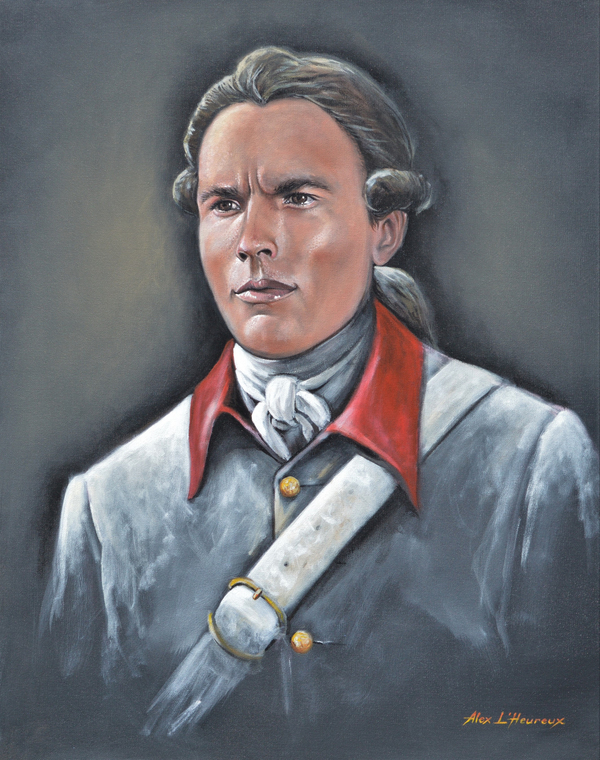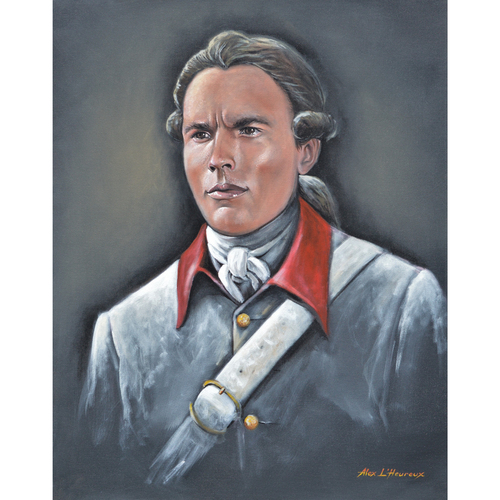
Source: Link
DENIS (Denys) DE SAINT-SIMON, ANTOINE-CHARLES, officer in the colonial regulars; b. 3 Nov. 1734 in Quebec, son of Charles-Paul Denys* de Saint-Simon and Marie-Joseph Prat; d. 8 June 1785 at Port-au-Prince, Saint-Domingue (Hispaniola).
Antoine-Charles Denis de Saint-Simon entered the colonial regulars as a cadet in January 1746 and from the outbreak of the Seven Years’ War served in the military campaigns in the Ohio River region. On 9 July 1755 he fought in the battle between the troops of Daniel-Hyacinthe-Marie Liénard* de Beaujeu and Edward Braddock near Fort Duquesne (Pittsburgh, Pa); the following year Governor Rigaud de Vaudreuil wrote to the minister of Marine: “He has been on all the reconnaissance missions and was involved in the General Braddock affair. He is still at the Belle Rivière [Ohio River], where he is constantly out skirmishing with the enemy.” Named second ensign in the colonial regulars on 1 May 1757, Saint-Simon was promoted ensign on the active list on 1 Jan. 1759. That year he campaigned in the Acadian borderlands, and in June 1760 made his way through the woods from Baie des Chaleurs to Montreal carrying the royal dispatches as soon as they arrived from Bordeaux.
His exploit had attracted the attention of Bougainville*, who in 1763 asked Choiseul that “this courageous and robust young man” be posted to his service for an expedition he was organizing to the Îles Malouines (Falkland Islands). Moreover, because Saint-Simon was used to dealing with native people and could command their respect, Bougainville wanted to appoint him to the general staff of the new colony. At this time Saint-Simon was in Tours with a group of Canadian officers who had been brought back to France after the conquest and he was finding life tedious. He raised some objections to Bougainville’s offers, because he wanted to return to Canada to settle family affairs, but the promise of a commission as an infantry captain to act as adjutant in the Îles Malouines finally persuaded him.
The expedition, which included some 40 Canadian or Acadian settlers, left Saint-Malo on 6 Sept. 1763. Saint-Simon sailed on board the corvette Sphinx, commanded by François Chenard de La Giraudais, and reached the Îles Malouines on 3 Feb. 1764. He was immediately sent on reconnaissance in the north and west of the archipelago. He helped to found the first settlements but in April returned to France with Bougainville, coming back to the new colony in January 1765 with 40 men of the colonial regular troops formerly stationed in Canada, a captain’s commission, and a brevet as adjutant.
In 1766, at the time of an expedition in the Straits of Magellan, Saint-Simon was instructed to conclude an alliance with the Patagonians. He sailed on the flute Étoile, commanded by La Giraudais, which left the Îles Malouines with the Aigle on 24 April. The first contacts with the Patagonians were made on 5 May. Saint-Simon handed over to them the traditional gifts of harpoons, blankets, red woollen caps, knives, cloth, pipes, and tobacco. The alliance was formally concluded on 1 June with a presentation of the king’s colours. When Bougainville sailed through the straits with the Boudeuse and the Étoile 18 months later he found this flag still in their possession. On this voyage Saint-Simon had proven himself a skilled diplomat, able to avoid incidents between the French and Patagonians, and the description he left of the people reveals he was also a good observer.
When the Îles Malouines were evacuated by the French in April 1767 after their cession to Spain, Saint-Simon boarded the Spanish frigate Liebre, which sailed for Montevideo, Uruguay, on 27 April. He did not reach El Ferrol (El Ferrol del Caudillo) in Spain until 12 Jan. 1768, and arrived in Lorient, France, in February. A new request to return to Canada does not seem to have met with success, and he went back to Tours, which was still serving as a reception centre for former Canadian officers. On 16 April 1769 he was appointed a captain in the Légion de Saint-Domingue; when this corps was disbanded, he transferred on 18 Aug. 1772 to the Régiment du Port-au-Prince and ended his career in the garrison there. On 24 Dec. 1773 he became a knight of the order of Saint-Louis.
Denis de Saint-Simon was always well regarded by his superiors. The governor of Saint-Domingue, the Marquis de Vallière, noted that he had “served at all times with the distinction of an excellent and brave officer.” His last commander, the Marquis de Laval, colonel of the Régiment du Port-au-Prince, wrote: “One can only speak highly of the zeal and the manner in which M. de Saint-Simon carried out his duties and did his service. . . . This officer is all the more worthy of the king’s favours because he sacrificed his fortune in Canada to continue to serve in France.”
AN, Col., C11A, 101, f.160v; D2C, 4, f.176; 59, f.44; 96, f.29; E, 363 bis (dossier Saint-Simony); F2A, 14; Marine, C7, 296 (dossier Denis de Saint-Simon); Section Outre-mer, G1, Port-au-Prince (Haïti), 8 juin 1785. ANQ-Q, État civil, Catholiques, Notre-Dame de Québec, 4 nov. 1734. Coll. des manuscrits de Lévis (Casgrain), I, 166; VII, 176; X, 141; XI, 82. [A.-J.-H. de Maurès de Malartic, comte de Malartic], Journal des campagnes au Canada de 1755 à 1760 . . . , Gabriel de Maurès de Malartic et Paul Gaffarel, édit. (Dijon, France, 1890), 335. [F.-]M. Bibaud, Le panthéon canadien choix de biographies, Adèle et Victoria Bibaud, édit. (2e éd., Montréal, 1891). [Bibaud confuses the career of Antoine-Charles Denis de Saint-Simon with that of Claude-Anne de Saint-Simon, Marquis (then Duke) of Saint-Simon (1743–1819), a major-general who took part in the War of American Independence and immigrated to Spain during the French revolution. é. t.] Tanguay, Dictionnaire. J.-É Martin-Allanic, Bougainville navigateur et les découvertes de son temps (2v., Paris, 1964). C.-F. Bouthillier, “La bataille du 9 juillet 1755,” BRH, XIV (1908), 222–23.
Cite This Article
Étienne Taillemite, “DENIS (Denys) DE SAINT-SIMON, ANTOINE-CHARLES,” in Dictionary of Canadian Biography, vol. 4, University of Toronto/Université Laval, 2003–, accessed January 19, 2026, https://www.biographi.ca/en/bio/denis_de_saint_simon_antoine_charles_4E.html.
The citation above shows the format for footnotes and endnotes according to the Chicago manual of style (16th edition). Information to be used in other citation formats:
| Permalink: | https://www.biographi.ca/en/bio/denis_de_saint_simon_antoine_charles_4E.html |
| Author of Article: | Étienne Taillemite |
| Title of Article: | DENIS (Denys) DE SAINT-SIMON, ANTOINE-CHARLES |
| Publication Name: | Dictionary of Canadian Biography, vol. 4 |
| Publisher: | University of Toronto/Université Laval |
| Year of publication: | 1979 |
| Year of revision: | 1979 |
| Access Date: | January 19, 2026 |



